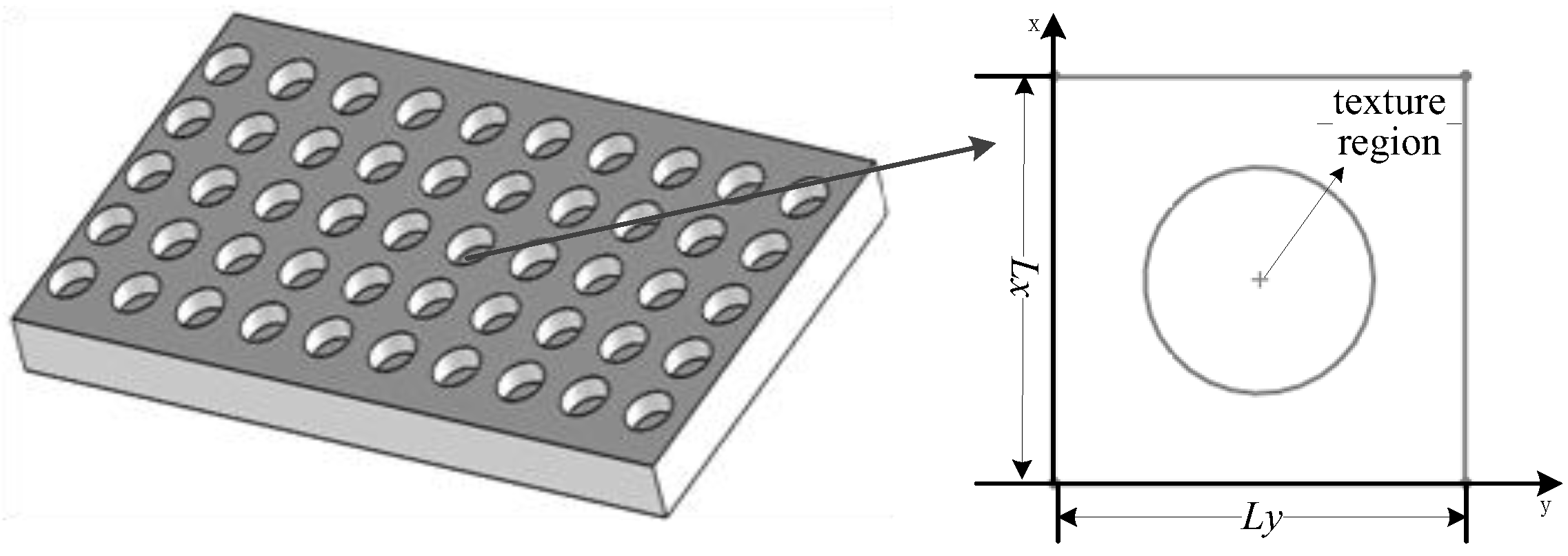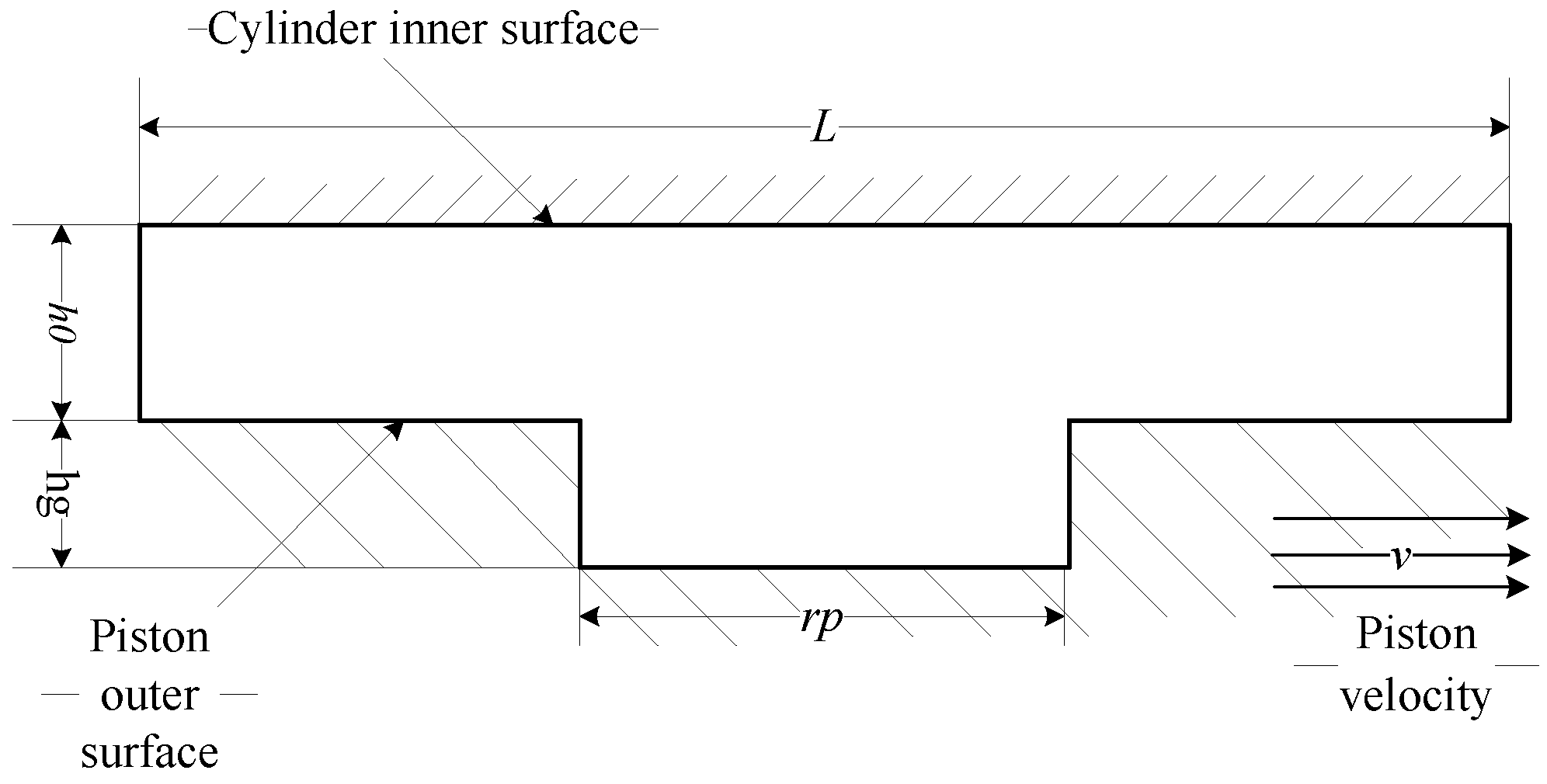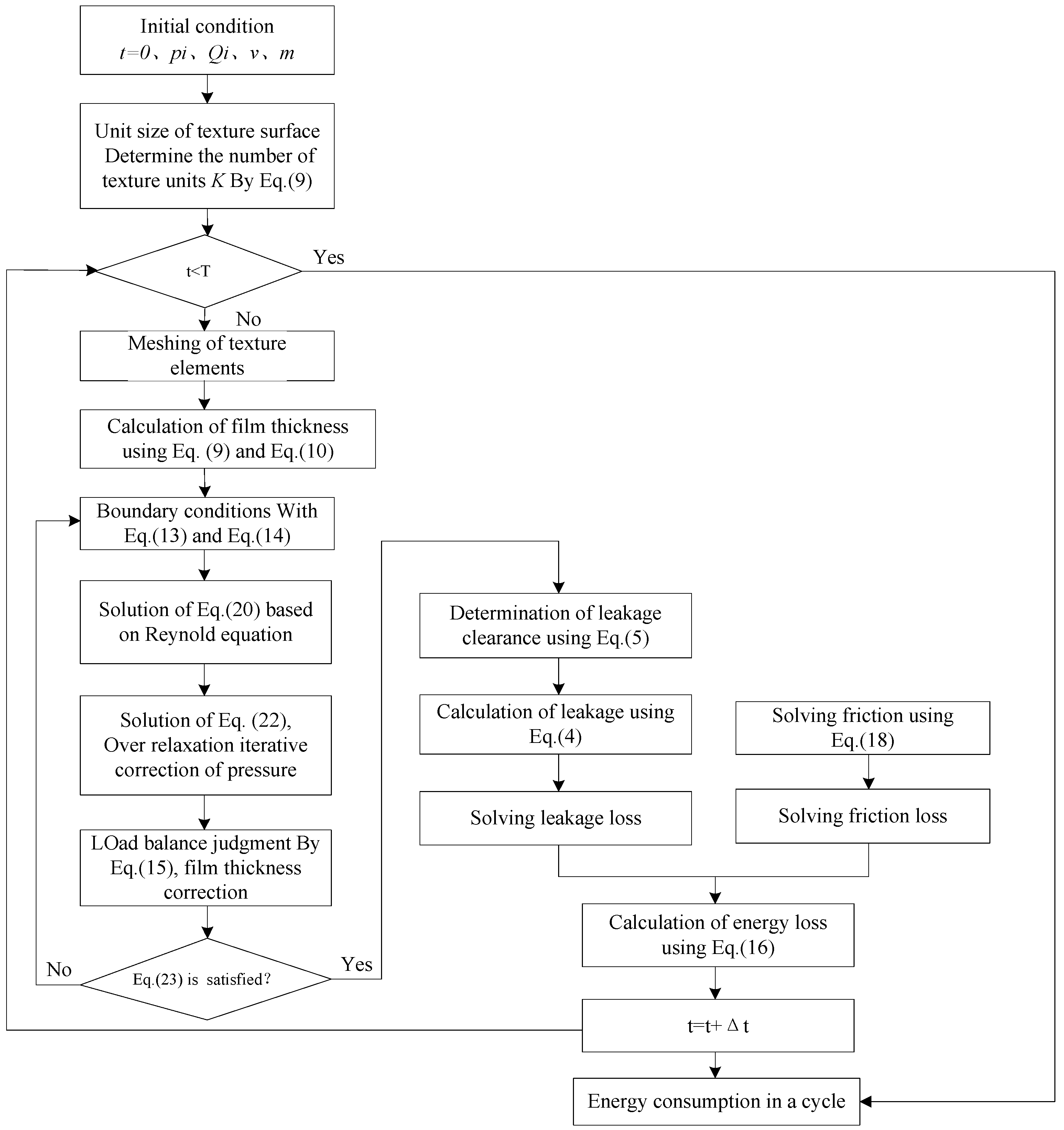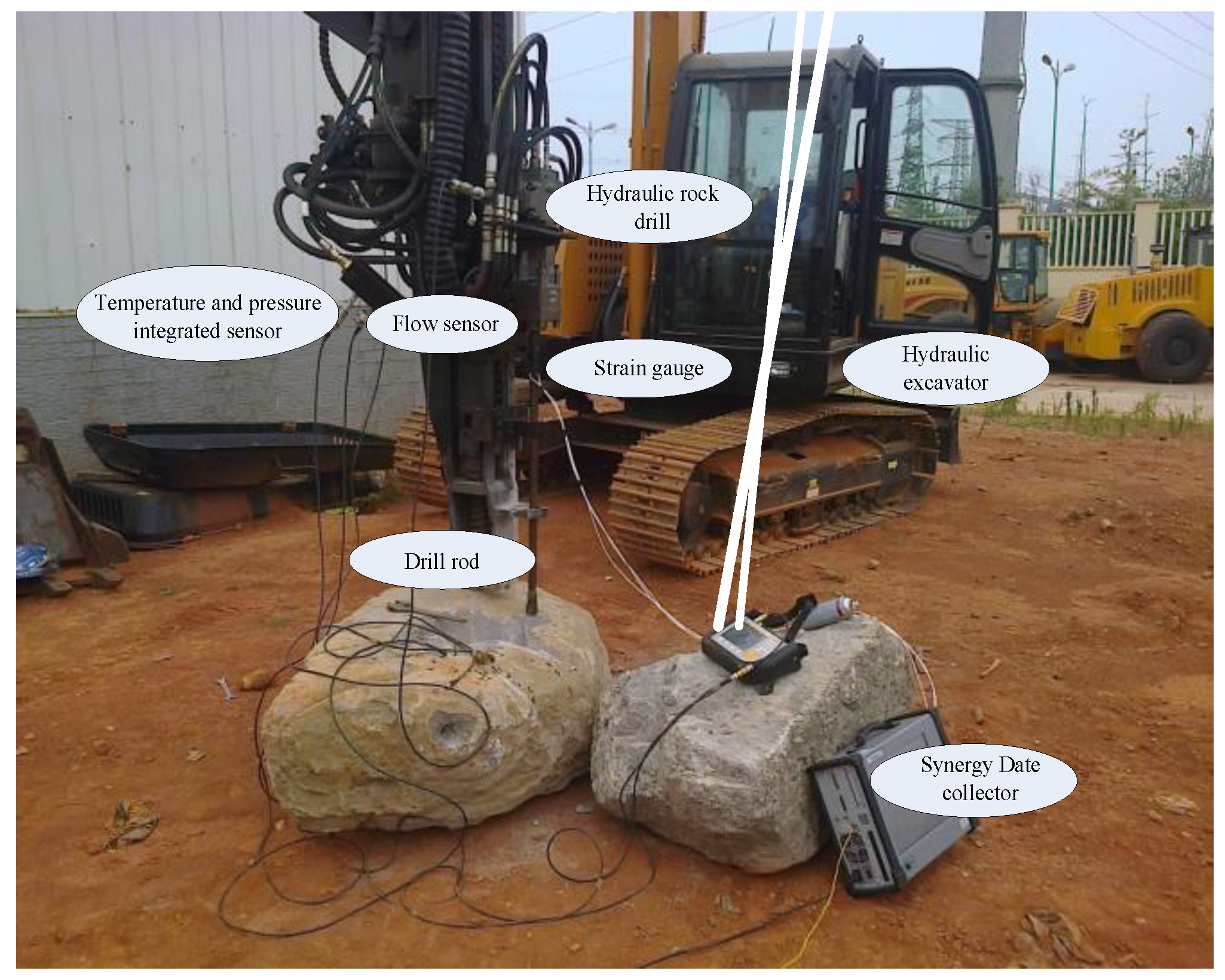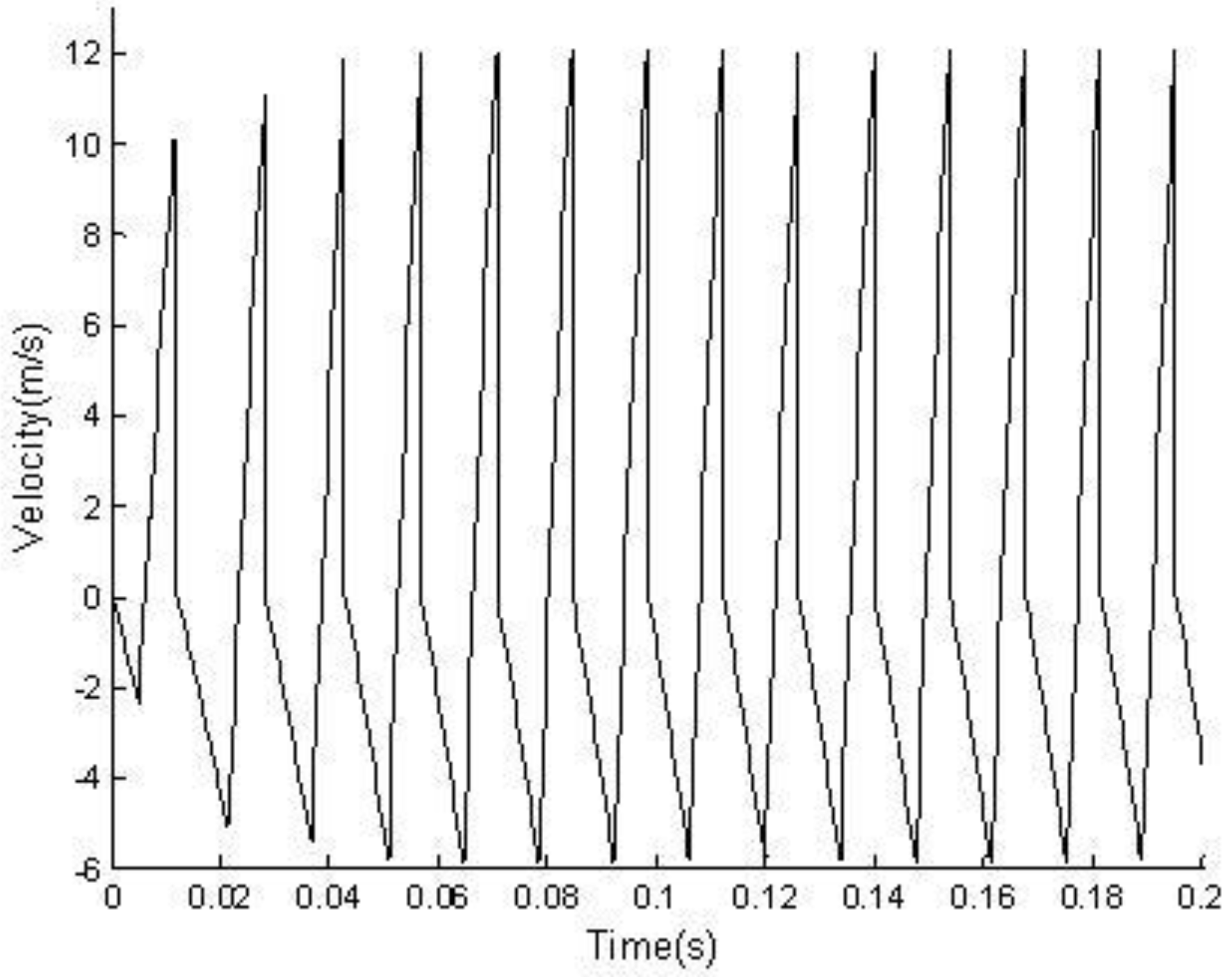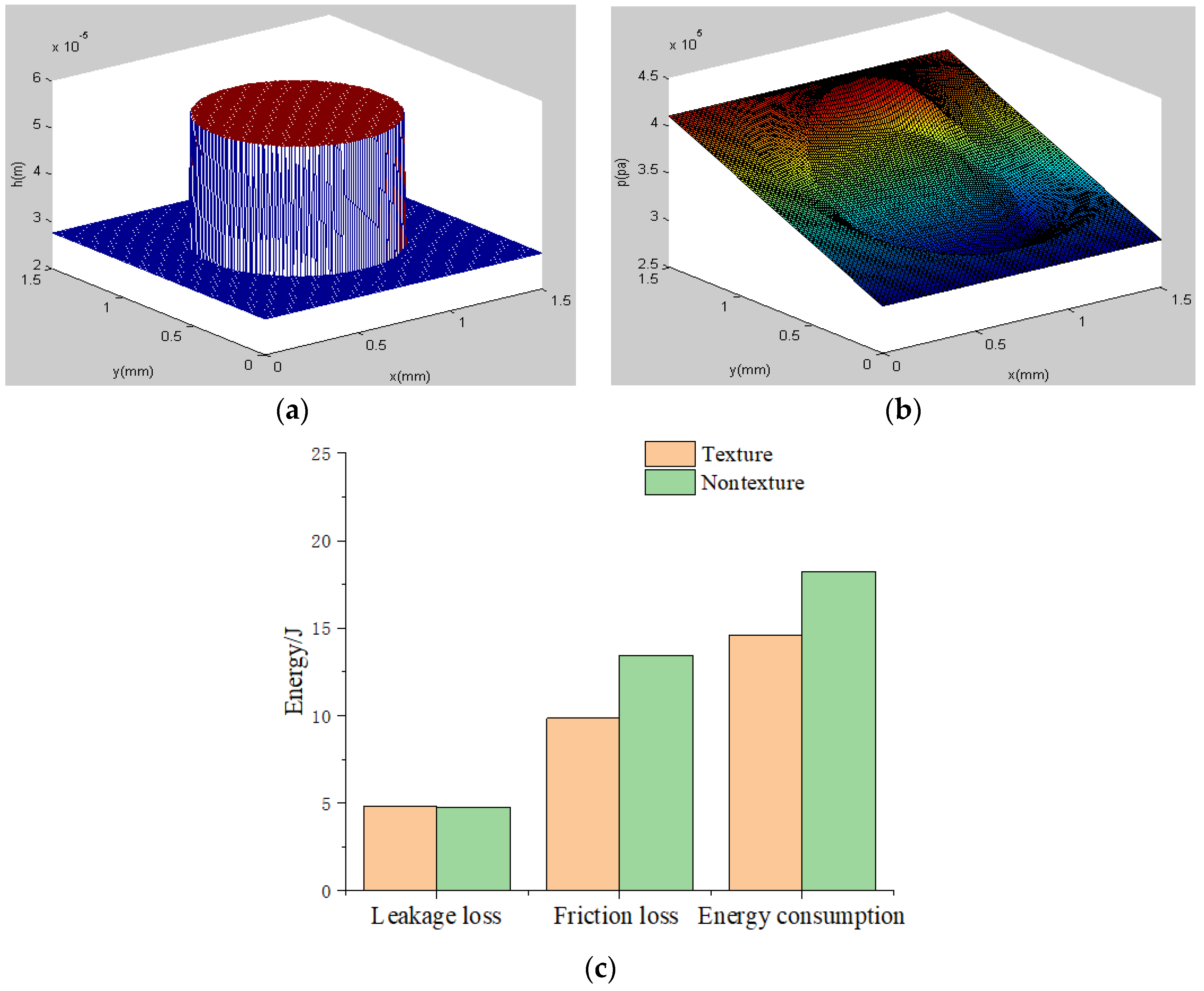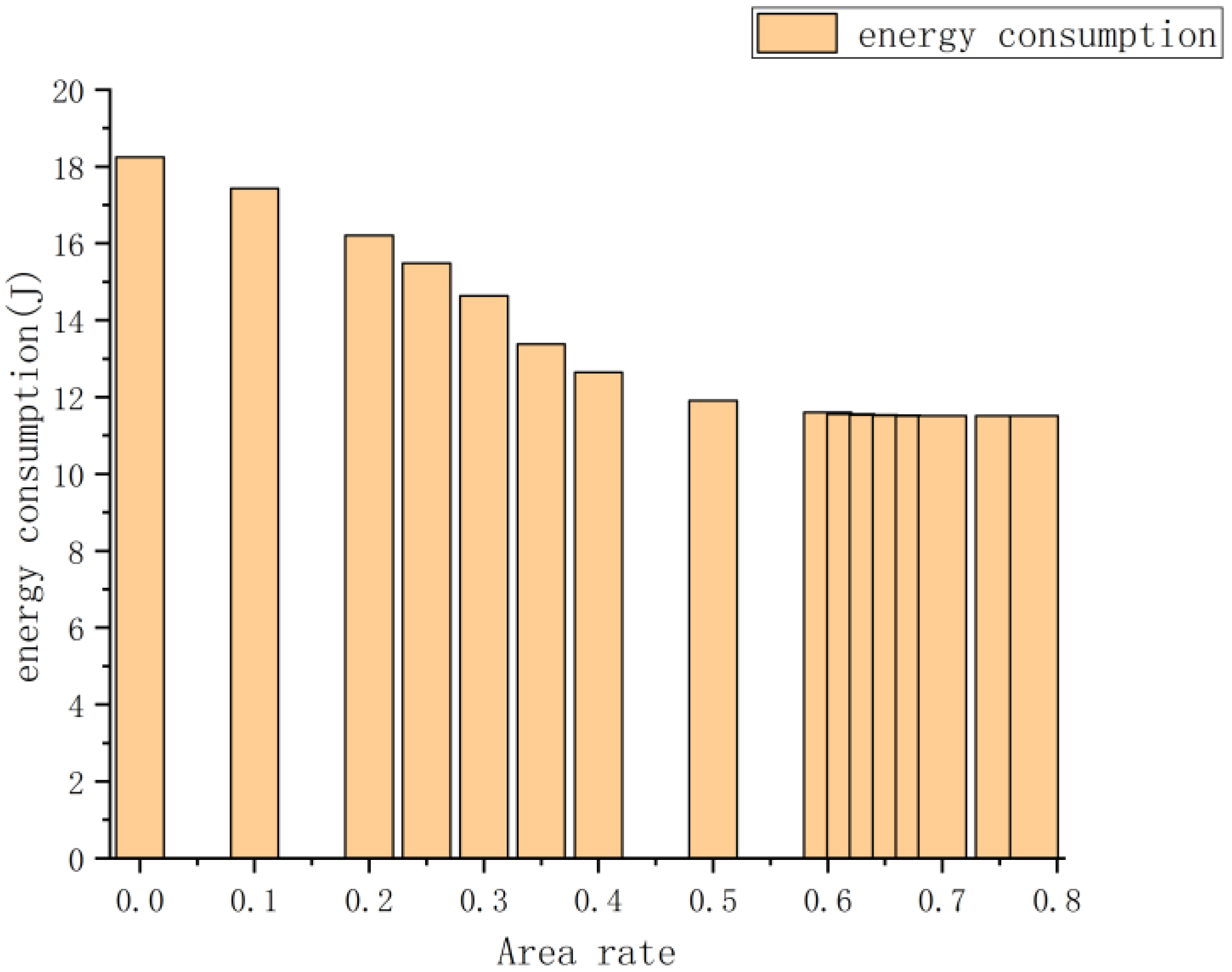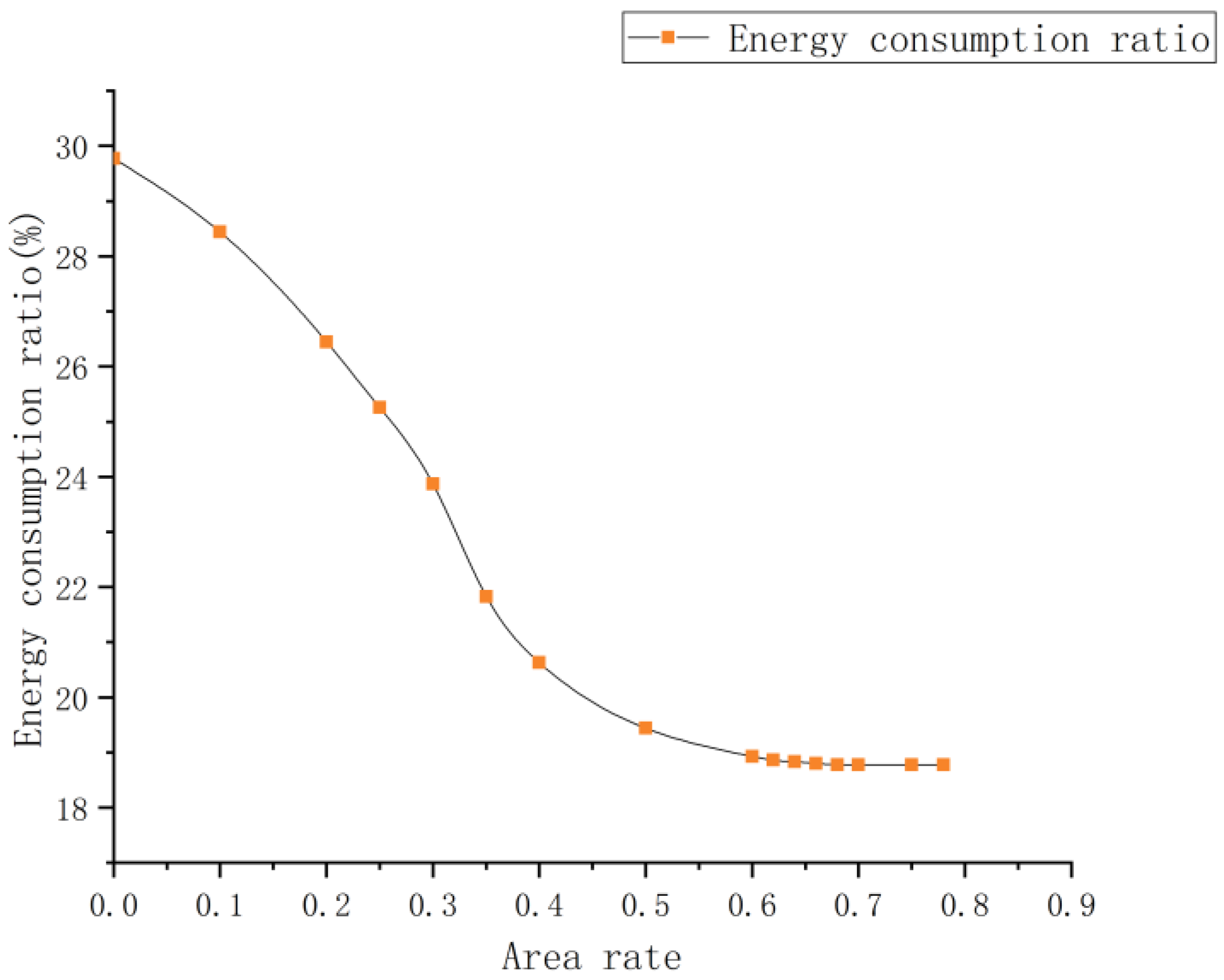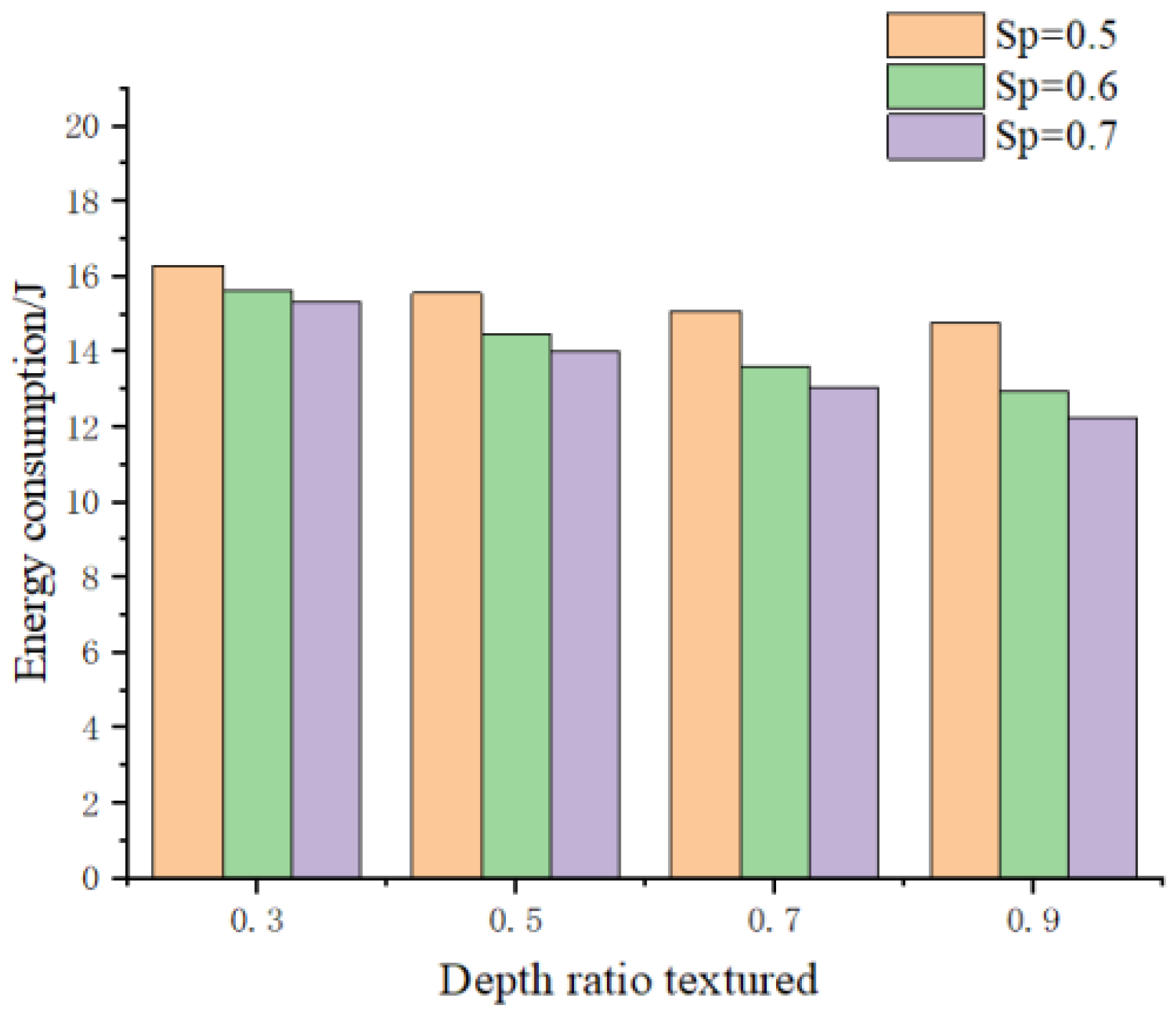1. Introduction
The energy utilization ratio of a hydraulic impactor is the ratio of piston impact energy to hydraulic energy. It reflects the conversion efficiency from hydraulic energy to mechanical energy of the hydraulic impactor and directly affects the drilling efficiency of the hydraulic impactor [
1,
2,
3,
4]. In the process of high frequency reciprocating, the friction loss and leakage loss of the piston pair are important parts in the total energy loss during energy transformation of the hydraulic impactor. The friction loss of the piston pair is caused by the clearance lubrication between the impact piston and the cylinder block, and the leakage loss is caused by the clearance seal. In order to improve the energy utilization rate of the hydraulic impactor, scholars at home and abroad have carried out a lot of research work on energy consumption calculation of the impact piston pair and optimization of piston structural parameters. Oh et al. [
5] developed an impact performance analysis tool through the analysis of a rock drill impact module and analyzed the variation law of energy utilization rate for the hydraulic impactor relative to rock stiffness. Seo et al. [
6] analyzed the performance of a hydraulic impactor through simulation considering the leakage and friction of an impact piston pair, then put forward the design method of structural parameters of an impact piston and determined the range of piston parameters. Flegneret et al. [
7] tested the friction and wear of a piston during the drilling process of a hydraulic impactor under different drilling pressures and rotational speeds. In view of avoiding premature wear, the design method of the piston structure parameters for enhancing the lubrication effect was put forward, and the range of piston parameters was determined. Wang et al. [
8] also established a kinematics mathematical model of an impact piston for a hydraulic impactor based on the Reynolds equation. The bearing capacity, cavity pressure, friction force, and friction energy consumption of the piston pair were studied. However, it is still limited to the conventional clearance lubrication and sealing mechanism in the design optimization of impact piston pairs mentioned above, which makes the design of declining energy consumption for an impact piston hard to realize. Increasing clearance reduces friction loss with leakage loss increase, and decreasing clearance decreases leakage loss with friction loss increase. It makes the improvement of energy utilization for a hydraulic impactor unsuccessful, and the energy utilization rate of a hydraulic impactor is much lower than that of other hydraulic actuators.
Surface texture is a micro geometric structure fabricated by special manufacturing technology on the surface with certain size, shape, and arrangement, such as micro pits and grooves. The additional hydrodynamic lubrication effect of texture can be used to improve the surface bearing capacity and reduce the surface friction [
9,
10,
11]. It has been widely recognized as an effective means for reducing friction, decreasing wear, and increasing surface bearing capacity [
12,
13,
14]. Pit texture is applied to the surface of the cylinder liner of an internal combustion engine to improve the lubricity of the piston pair, and the friction between the piston ring and cylinder liner is greatly reduced accordingly [
15,
16]. The groove texture is applied to the bearing surface to reduce the friction on the bearing surface with a more stable working parameter [
17,
18,
19]. It has also been shown by many scholars that different morphology and parameters of texture have a significant influence on surface friction loss. Hui Zhang et al. [
20] studied the friction force of surface texture parallel sliders with different morphologies and found that the hydrodynamic lubrication performance of circular textures is better with lower friction. Daniel Gropper et al. [
21] analyzed the performance of bearing with variation of texture area and textured depth on a surface and found that the optimum texture depth should be slightly less than the minimum film thickness of an unreformed bearing and that an optimum texture depth and density with low friction existed. Wang et al. [
22] carried out research on texture density and discovered that the friction force was reduced favorably with a texture density of 5~13%.
In order to improve the energy efficiency of a hydraulic impactor, an impact piston pair structure with a cylindrical texture is put forward. By analyzing the physical and mechanical mechanism of energy consumption of the impact piston pair, the energy consumption analysis model of the impact piston pair was established and solved numerically when combined with the Reynolds equation. The effect of texture parameters on the energy consumption of the impact piston was obtained, which provides a theoretical basis with which to design a high frequency hydraulic impactor with surface texture on the impact piston.
3. Analysis Model of Energy Consumption for Textured Impact Piston Pair with High Frequency
When establishing the energy consumption analysis model of the textured high-frequency impact piston valve, the following assumptions were made: the hydraulic oil is a Newtonian fluid; the cylinder-piston belongs to a rigid body, and the piston has no eccentricity in the cylinder; ignore the change in hydraulic oil temperature during piston movement.
In the process of high frequency reciprocating, the friction loss and leakage loss of piston pair are important parts in total energy loss during the energy transformation of the hydraulic impactor. The friction loss of the piston pair is caused by clearance lubrication between the impact piston and the cylinder block and by the leakage loss caused by the clearance seal. In this study, energy consumption for the impact piston pair is evaluated in a cycle considering both friction loss and leakage loss. During the movement of the impact piston, the clearance between the impact piston and the cylinder block is filled with hydraulic oil to avoid direct contact with the cylinder block. The relative motion of the impact piston and cylinder block results in a dynamic oil film in the clearance. The friction force of the dynamic pressure the oil film on a solid surface is caused by the shearing force of oil. When the velocity of the impact piston increases, the friction forces increase, caused by the increase in shear force. In addition, the seal form between the impact piston and the cylinder block is the clearance seal. Hydraulic oil leakage exists at the two ends of the impact piston pair under the action of the pressure difference between the two ends of the impact piston, which will cause leakage loss.
3.1. Energy Consumption Evaluation Index of Impact Piston Pair
Considering the leakage and friction loss of the impact piston pair, the energy consumption of the impact piston pair in one cycle is calculated as follows:
where
W is the energy consumption of impact piston pair in one cycle,
is the leakage loss of impact piston pair in one cycle,
is the friction loss of impact piston pair in one cycle,
PLt is the leakage power of impact piston pair at time
t,
PFt is the friction power of impact piston pair at time
t,
T is the motion cycle of hydraulic impactor with high frequency.
3.2. Leakage Loss Calculation
Leakage loss power is determined by the pressure difference and leakage flow at both ends of the impact piston. The calculation of the loss energy of the piston pair leakage can be expressed by:
where
WL is the leakage loss of the impact piston pair in one cycle,
PLt is the leakage power of impact piston pair at time
t, Δ
pt is the pressure difference between two ends of impact piston pair at time
t determined by working condition,
QLt is the leakage flow at time
t,
T is the motion cycle of hydraulic impactor with high frequency.
Leakage flow varies with the change in relative velocity between the impact piston and the cylinder block. The impact piston and cylinder block are completely concentric, and the seal clearance is very small. Hence, it can be regarded as concentric ring clearance. Under the conditions of the relative motion between the piston and the cylinder, the leakage flow is the flow of the hydraulic oil in the annular clearance. It can be calculated by the flow formula of the annular clearance:
where
QLt is the leakage flow at time
t,
d is the diameter of the impact piston,
ht is the leakage clearance at time
t, Δ
pt is the pressure difference between two ends of impact piston pair at time
t determined by working condition,
η is the dynamic viscosity of the hydraulic oil,
l is the runner length,
vi is the relative velocity of the impact piston and cylinder block at time
t.
The structure of texture unit is consistent and symmetrical. The leakage clearance at time
t can be approximated by the minimum film thickness of a texture element:
where
ht is the leakage clearance at time
t,
h(x,y) is the film thickness distribution function of texture units.
The cross section model of the flow field for a control unit with cylindrical texture is shown in
Figure 4. In the figure,
v is the velocity of the impact piston,
h0 is the minimum initial clearance between cylinder block and impact piston,
hg is the height of cylindrical texture element. Considering contact deformation under oil film pressure, the actual oil film thickness distribution function of the texture flow field can be expressed as follows:
where
h0 is the minimum initial clearance between the cylinder block and impact piston,
hg is the height of the cylindrical texture element,
v(x,y) is the contact deformation,
rp is the radius of the bottom surface of the cylindrical texture element.
where
v(
x,
y) is the contact deformation,
E is the equivalent elastic modulus,
p(
s,
z) is the oil film pressure,
Lx is length of control unit along
x axis, and
Ly is length of control unit along
y axis.
3.3. Friction Loss Calculation
In one stroke, the change of velocity causes a change in oil film thickness, and the change in oil film thickness directly affects the friction loss of the piston pair. Therefore, the speed of the impact piston determines the loss of friction power. The equation for calculating the friction loss energy of the piston pair can be expressed by:
where
WF is the friction loss of the impact piston pair in one cycle,
PFt is the friction power of the impact piston pair at time
t,
vi is the relative velocity of the impact piston and cylinder block at time
t input according to experimental test data,
Fft is the impact piston friction at time
t,
T is the motion cycle of the hydraulic impactor with high frequency.
Assuming that the friction produced by each texture unit is the same and that the impact piston is a rigid body, the friction force to be applied to the impact piston at time
can be expressed as:
where
Fft is the impact piston friction applied to the impact piston at time
t,
Ffdt is the friction produced by single texture unit at time
t,
K is the total number of texture units,
,
d is the diameter of the impact piston,
l is the runner length,
Lx is length of control unit along the
x axis,
Ly is length of control unit along the
y axis.
The friction force of the dynamic pressure oil film on a solid surface is caused by the shearing force of oil. According to Newton’s internal friction theorem, the friction force of a single texture unit can be obtained by integrating the shear stress in the contact fluid layer along the control element.
where
Ffd is the friction force of a single texture unit of the impact piston,
h is the oil film thickness,
p is the oil film pressure,
v is the relative velocity of the impact piston and cylinder block,
is the dynamic viscosity of hydraulic oil,
is length of the control unit along the
axis,
is length of the control unit along the
axis.
3.4. Oil Film Pressure Calculation for Textured Impact Piston Pair
Based on the previous assumptions and the formation mechanism of oil film pressure, the Reynolds equation of incompressible fluid under isothermal condition is written as [
10]
where
is the density of hydraulic oil,
is the oil film thickness,
is the oil film pressure,
is the dynamic viscosity of hydraulic oil,
is the relative velocity of the impact piston and cylinder block.
Ignoring the change in oil density and viscosity, Equation (11) can be simplified as
where
is the simplified coefficient,
is the initial dynamic viscosity of hydraulic oil,
is the relative velocity of the impact piston and cylinder block.
There is a certain height gradient on the textured surface, which contains the convergence wedge and divergence wedge. Assuming that the oil film pressure is periodically distributed, the Reynolds cavitations boundary condition in fluid lubrication can be written as
Assuming that the pressure on both sides of the impact piston changes linearly, the single texture unit has a certain pressure drop, and the oil film boundary conditions can be obtained as follows:
where
is the pressure difference between two ends of impact piston,
is the supply oil pressure,
is the return oil pressure,
is the number of nodes of the texture element along the
axis.
In addition, the oil film pressure distribution should satisfy the load balance equation, as shown in Equation (15):
where
is the equivalent load, according to the boundary conditions
,
is the supply oil pressure,
is the return oil pressure,
is the number of nodes of the texture element along the
axis,
is length of control unit along the
axis,
is length of the control unit along the
axis.
The oil film pressure is solved with boundary conditions according to Equation (12). If the load balance equation is satisfied, the pressure distribution value of the texture unit can be obtained.
4. Numerical Solution of Energy Consumption Model for Textured Impact Piston Pair with High Frequency
After determining the size of the texture unit, the length of the texture unit along the
axis is divided into
nodes, and the length of the texture unit along the
axis is divided into
nodes. According to Equations (2), (3) and (8), taking the calculated step size as
, the energy consumption in a cycle can be solved numerically by the following equation:
where
is the energy consumption of the impact piston pair in one cycle,
is the number of periods in a cycle
I = T/Δ
t,
is the motion cycle of hydraulic impactor with high frequency,
is the calculated step size,
is the pressure difference between two ends of impact piston at time
,
is the leakage flow of hydraulic oil at time
,
is the impact piston friction applied to the impact piston at time
,
is the velocity of the impact piston at time
.
Combining Equations (9) and (10), the friction force can be solved by using the composite trapezoid formula, which is shown as:
where
is the impact piston friction applied to the impact piston at time
,
is the total number of texture units,
is the diameter of the impact piston,
is the runner length,
is length of control unit along the
axis,
is length of control unit along the
axis,
is the number of nodes of the texture element along the
axis,
is the number of nodes of the texture element along the
axis,
is the thickness of oil film at the intersection of
direction node
and
direction node
,
is the pressure at the junction of
direction node
and
direction node
,
is the mesh length along the
axis,
is the coefficient matrix, which is written as:
The contact deformation can be solved simply by the step function approximation method, that is:
where
is the elastic deformation at the node (
,),
is the deformation produced by the unit force of the node (
,) at the node (
,).
where
,
is the mesh length along the
axis,
is the mesh length along the
axis.
Using the difference solution method to deal with the Equation (12), the iterative formula for calculating the pressure can be obtained:
where band mark
is uncorrected pressure, belt mark
is modified pressure,
is the node number of
direction,
is the node number of
direction,
is the calculated coefficient, which can be expressed in the following:
where
is the mesh length along the
axis,
is the mesh length along the
axis,
is node number along the
axis,
is node number along the
axis,
is the oil film thickness,
is the simplified coefficient,
is the initial dynamic viscosity of hydraulic oil,
is the relative velocity of the impact piston and cylinder block.
In order to ensure the convergence of the calculation, the super relaxation iteration method is used to modify the algorithm, that is:
where
is the oil film pressure,
is node number along the
axis,
is node number along the
axis, band mark
is the uncorrected pressure, belt mark
is modified pressure,
is the relaxation iteration factor.
The convergence judgment is carried out with relative precision, as follows:
When the solution of oil film pressure is convergent, the impact piston friction applied to the impact piston can be calculated using Equation (17) by substitution of the oil film pressure solution, and the energy consumption of the impact piston pair can be calculated according to Equation (16). The specific solution process is shown in
Figure 5.
6. Conclusions
According to the characteristics of reciprocating periodic motion with high frequency, the energy consumption analysis model of the textured impact piston pair was established. The model was used to analyze the energy consumption of the impact piston pair of a YG-45 hydraulic impactor. The results show that:
(1) The energy consumption of the impact piston pair accounted for 29.77% in the total energy loss of the hydraulic impactor. Reducing the energy consumption of the impact piston pair was an effective way of improving the energy utilization rate of the hydraulic impactor.
(2) The energy consumption of the impact piston pair with cylindrical texture was reduced regardless of the area ratio textured. The energy consumption ratio decreased by 1.32% to 10.98% with the area ratio textured ranging from 0.1 to 0.78, and the energy consumption ratio can be reduced to the lowest when the area ratio textured is in the range of 0.64 to 0.70.
(3) The energy consumption of impact piston pair with cylindrical texture was also reduced regardless of the depth ratio textured, but the value by which it was reduced was slight. The energy consumption ratio decreased by 3.21% to 5.68% with the depth ratio textured ranging from 0.3 to 1.3, and the energy consumption ratio can be reduced to the lowest when the depth ratio textured is in the range of 1 to 1.1.0.


